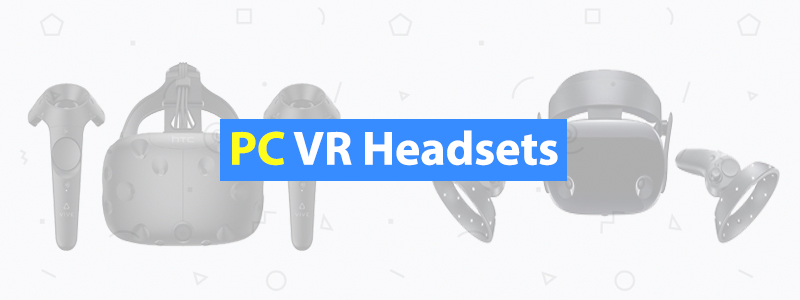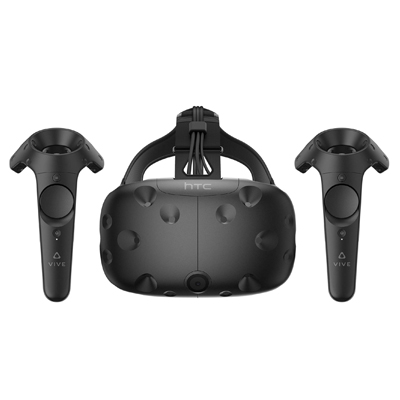5 Best VR Headsets for PC
Virtual reality is here. After decades of dreaming and failed attempts to bring the technology to consumers, virtual reality has now become somewhat mainstream.
Currently, the best way to experience virtual reality is with a state-of-the-art PC headset. This has been the case from day one and even though huge advancements are being made with mobile and standalone headsets, PC remains the way to go if you are after the best VR experience possible.
In this guide, we will look at the best virtual reality headsets available for PC and compare their pros and cons, allowing you to figure out which headset is the best for you.
| Budget |
|---|
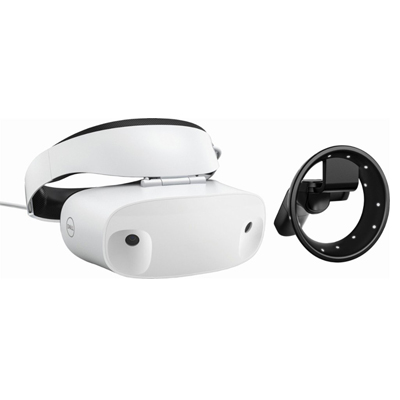 |
| Dell Visor Mixed Reality Headset |
| 4.3/5.0 |
| Field of view: 105 degrees |
| Display: 2880 x 1440 Dual LCD 2.89” Diagonal |
| Tracking: Inside-out Tracking |
| Low cost and a high-resolution display. |
| Check Amazon |
| Best Value |
|---|
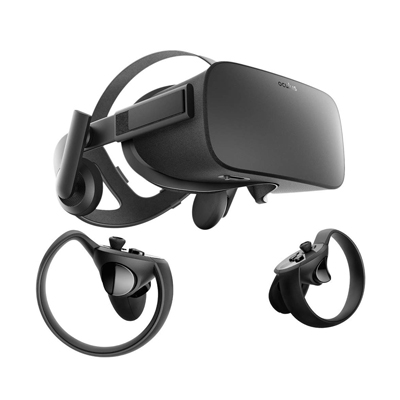 |
| Oculus Rift + Touch VR Headset |
| 4.6/5.0 |
| Field of view: 110 degrees |
| Display: 2160 x 1200 Dual OLED Display |
| Tracking: Constellation |
| Very precise headset, with average resolution. |
| Check Amazon |
| Top Pick |
|---|
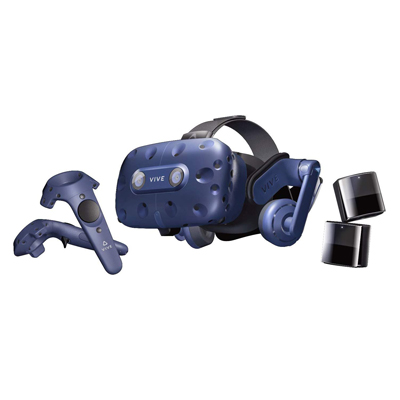 |
| HTC Vive Pro VR Headset |
| 4.8/5.0 |
| Field of view: 110 degrees |
| Display: 2880 x 1600 Dual AMOLED 3.5” |
| Tracking: Vive Base Stations |
| Highest resolution display you can get. |
| Check Amazon |
What makes a PC headset so much better than Mobile and Standalone?
Modern VR headsets typically fall into one of two categories: mobile or tethered. PC headsets are the latter. This may seem like a negative as the headset needs to be connected to the PC, however, this connection is the reason PC headsets are able to work as well as they do.
By tethering a headset to a PC you can put the computer in charge of all of the video processing. The cables may seem a bit of nuisance as a result but this is a much better option than having to add extra components to the headset. It also means that the VR experience can be a lot more complex.
An example of this is accurate position tracking. Most mobile headsets use three-degrees-of-freedom (3DOF) motion tracking which means the can only track the direction you are looking in. PC headsets, on the other hand, use 6DOF motion tracking, meaning they are also able to track your position.
This extra dimension of tracking is made possible by either external sensors or outward facing cameras. Either way, it creates a far more immersive experience as the headset is able to track any direction you move in, whether it be forwards, backward, left, right, up, or down.
Another benefit of PC VR headsets is the image fidelity. This is because PC headsets have a dedicated display, rather than relying on the display of a smartphone. The use of a dedicated display usually means greater color accuracy as well as sharper, smoother imagery especially when moving.
The downside with PC VR headsets is the price. These extra features aren’t cheap and in most cases, you will be looking at a significant increase in price when compared with a mobile headset. There is also the added cost of the PC, which will need fairly high specs to actually power the VR headset effectively. Many of you will already have a decent PC, but for those who don’t, it is an added cost worth considering.
That being said, PC VR headsets are a much better option for those who are looking for the best VR experience possible, and if you fall into that group then you will likely view the investment as worthwhile.
Best VR Headsets for PC Comparison Table
| Make and Model | Field of View | Displa | Controllers | Price Check |
|---|---|---|---|---|
| Oculus Rift+ Touch Virtual Reality Headset | 110 degrees | 2160 x 1200 Dual OLED | Oculus Touch controller, Oculus Remote, Xbox One controller | Check Price |
| HTC Vive Virtual Reality Headset | 110 degrees | 2160 x 1200 Dual OLED 3.6” Diagonal | Vive controller, any PC compatible controller | Check Price |
| HTC Vive Pro Virtual Reality Headset | 110 degrees | 2880 x 1600 Dual AMOLED 3.5” Diagonal | Vive controller, any PC compatible controller | Check Price |
| Dell Visor Mixed Reality Headset | 105 degrees | 2880 x 1440 Dual LCD 2.89” Diagonal | Microsoft Motion controllers | Check Price |
| Samsung Electronics HMD Odyssey+ Mixed Reality Headset | 110 degrees | 2880 x 1600 Dual AMOLED 3.5” Diagonal | Microsoft Motion controllers | Check Price |
1. Oculus Rift + Touch Virtual Reality Headset (Best Value)
Editor’s Rating: 4.6/5.0
The Oculus Rift is arguably the most well known VR headset available. This is largely due to it establishing itself as the original benchmark in VR, however, it is also down to the fact that it is a remarkable piece of technology.
The device was launched in early-2016 and after enduring a somewhat rocky start, it has become fairly mainstream, with the headset being sold on a number of different websites including Amazon, Game, and of course, Oculus. During that time the Oculus Rift has also seen a significant drop in price, meaning that it is a much more justifiable purchase now, compared to what it was back then.
One of the first things you will notice about the Rift is its design. It could be argued that this is the nicest looking headset on the market, especially when you compare it to the likes of the HTC Vive, which still has somewhat of a prototype look about it.
Unlike the plastic shell found on the Vive, the Rift has a sleek fabric finish, giving it a stealthy appearance. It also has a much simpler head strap, adding to the clean, almost minimalist design. According to Oculus, the fabric isn’t just for show. It actually helps reduce condensation build-up which can be an issue with some headsets, especially after long periods of use.
The field of view on the Oculus Rift is around 110 degrees. This puts it amongst the best in this category, which is expected but also impressive, given that this headset is now a few years old. In fact, it is only in recent times that headsets offering a wider field of view have hit the market but these are mobile headsets so the experience isn’t really comparable.
The Rift uses an OLED panel with a resolution of 2160 x 1200. Per eye, this gives you a resolution of 1080 x 1200. This is a pretty high-resolution display, however, there is a good chance you will still see some pixels when using the headset. It shouldn’t be too distracting but just bear in mind that you won’t be getting a crystal clear display and this will could affect your experience in terms of immersion.
One of the best things about the Oculus Rift is its controllers. The Touch controllers are excellent for a number of reasons. For starters, they are a lot smaller than the Vive Wands for example, and they will fit comfortably in your hand thanks to their design that almost wraps around your hands.
They are also tracked in the same way as the headset, meaning you can interact with your environment in the same way as you would with the Vive. This is something that was previously exclusive to that headset only.
If, however, you would prefer to use a different controller with the headset, the Oculus Rift is also compatible with the Xbox One controller as well as the Oculus Remote, so there are other options available. It is important to note though, that the immersive experience won’t be quite as good if you do decide to use an alternative controller.
The tracking system used on the Oculus Rift is known as Constellation. It is Oculus’ version of outside-in tracking and it works by setting up sensors in the space you wish to use, which then track the headset and controllers thanks to infrared sensors in each device. This implementation helps keep the Oculus Rift very lightweight, therefore, increasing overall comfort.
One last thing to note about the Oculus Rift is its built-in headphones. These are no ordinary headphones as they offer 3D spatial audio which significantly improves the level of immersion that you experience. If you would still rather use your own headphones though, you will be pleased to know that they can be removed. Having said that, the built-in headphones sound amazing so you might find that you just stick with them instead.
The only thing that really lets the Oculus Rift down is its display. Although it has the benefit of being OLED, the resolution isn’t as high as it could be and it could really do with an update. Other than that though, the headset is excellent and once it is set up correctly, you should little to no complaints.
| Tech Specs |
|---|
| Field of view: 110 degrees |
| Display: 2160 x 1200 Dual OLED |
| Controllers: Oculus Touch controller, Oculus Remote, Xbox One controller |
| Tracking System: Constellation |
| The Pros |
|---|
| Wide field of view |
| Among the highest on this list |
| High resolution |
| OLED panel |
| Can be used with a variety of different controllers |
| Supports the Xbox One controller |
| Accurate tracking |
| Minimal drift |
| The Cons |
|---|
| Screen width not specified |
| Higher resolution headsets available |
| Might not be compatible with all third-party controllers |
| Constellation cameras have to be connected to a PC by cable, even if they across the room |
| Smaller room scale tracking than the Vive |
2. HTC Vive Virtual Reality Headset
Editor’s Rating: 4.5/5.0
The HTC Vive is the headset that poses the biggest threat to the Oculus Rift for a number of reasons including its specs and its price-point. Although there are many areas where the Rift clearly excels, the Vive has some tricks of its own that allow it to pull ahead of its competition in certain areas.
First of all, let’s look at the Vive’s design. Unlike the fabric cover used on the Rift, HTC has decided to go with an all plastic design. Although this might improve durability somewhat, the headset will likely be more prone to condensation issues as the Rift uses the fabric as a way to improve breathability.
You will also have noticed what appears to be a number of holes dotted all over the headset. These are actually where the light detectors are housed for room scale tracking. Although these are an important feature of the headset, it is hard to look past the fact that they give the device an almost bug-like appearance.
The field of view for on the HTC Vive is 110 degrees keeping it on par with the Rift and other PC headsets. This gives you excellent viewing angles that are currently only being topped by some mobile headsets, but again, the overall immersion from a PC headset is far greater than anything Mobile headsets are currently able to offer.
The display on the HTC Vive is also 2160 x 1200, just like the Oculus Rift. The similarities don’t end there either as the Vive also uses an OLED panel. This means that both headsets will pretty much offer you the same experience in terms of visuals, which is both good and bad, considering that the display on the Rift is arguably the main thing letting it down.
The HTC Vive can either be used with its own Vive Wands or any other third-party controllers. The Vive Wands were one the Vive’s best selling points before Oculus released the Touch controllers. This doesn’t mean that the Vive controllers aren’t good because they certainly are, but the Oculus Touch controllers are generally better in terms of functionality.
The tracking system used on the HTC Vive is known as the Vive Base System. This is where the Vive really holds its own as this tracking system is excellent. It is also known as the Lighthouse tracking system and it works by setting up two black boxes that create a 360-degree virtual space up to 15ft x 15ft.
This is a dramatic improvement over the Oculus Rift as the Constellation system is recommended to be used in a space around half that size. The Vive also has those 37 sensors in the headset that provide fluid movement as well as a front facing camera. This camera allows for a chaperone safety system that casts a blue line on walls and object within the virtual space when you get too close to them.
This is a very useful feature as it can be easy to lose track of your position in a room when you are wearing a high-end headset such as the Vive, especially during long periods of use. There is an optional camera accessory which can be bought to achieve the same thing on the Rift, but having it already built into the headset is much more convenient.
One thing the HTC Vive doesn’t have though is built-in headphones. This isn’t the end of the world as you can simply use your own headphones instead, but considering how good the Rift’s headphones are, it would have been nice to see something comparable on the Vive.
The Vive is an excellent headset with an amazing tracking system, however, it does lack a few features when compared with other headsets at this price-point. Having said that, if you are planning to experience VR in a larger room, then this is definitely a worthwhile purchase.
| Tech Specs |
|---|
| Field of view: 110 degrees |
| Display: 2160 x 1200 Dual OLED 3.6” Diagonal |
| Controllers: Vive controller, any PC compatible controller |
| Tracking System: Vive Base Stations |
| The Pros |
|---|
| Wide field of view |
| Among the highest on this list |
| High resolution |
| OLED panel |
| Excellent compatibility with third-party controllers |
| Accurate tracking |
| Minimal drift |
| Can track a space of up to 15ft x 15ft |
| The Cons |
|---|
| Higher resolution headsets available |
| Not as functional as the Oculus Touch controllers |
3. HTC Vive Pro Virtual Reality Headset (Top Pick)
Editor’s Rating: 4.8/5.0
The HTC Vive Pro is essentially the headset that we wish the Vive already was. The difference, however, is the significant increase in price that comes with the Pro version. The price-tag isn’t completely unjustified though as there are a number of things on this device that when put together, make it the most high-end headset currently available to consumers.
Just from looking at the headset you can already begin to see some of the differences between the Vive Pro and the standard Vive headset. Aside from the color scheme, arguably the first thing that is immediately noticeable is the second camera. When the headset was first shown to the public the exact purpose of this second camera was unknown, however, it has now been specified that both lenses are stereoscopic cameras with tracking abilities.
This means that the Vive Pro has the ability to track hand gestures, although, at the moment the VGA resolution isn’t good enough to support inside-out tracking which is a bit of shame, again considering the price-tag.
The other big addition to the Vive Pro is built-in headphones. This was one of the main things the Vive lacked when compared to Oculus Rift, but HTC has made sure to include them on the Pro version and they are really good.
Another, less noticeable improvement on the Vive Pro is the new chassis. HTC says that the new design more evenly distributes the weight of the headset, meaning the device should feel lighter and more secure on your head when compared to the original Vive. There is also a knob at the back of the device to help tighten the Vive Pro around your head which is something the original Vive doesn’t have.
Apart from that, the Vive Pro is generally more comfortable to wear and better at keeping out light which can be an issue, especially on cheaper headsets.
Aside from the design of the device, there is one area of the Vive Pro that boasts a huge improvement over the original Vive and that is the display. The Vive Pro uses a Dual AMOLED setup with a combined resolution of 2880 x 1600. This gives you a resolution of 1440 x 1600 per eye, which is a dramatic increase over the original Vive, especially when you consider how close your eyes will be to the display.
It also means there is a significant reduction in how many pixels will be visible to you when you are wearing the headset. The Vive pro’s visuals are also more vibrant and sharper, meaning smaller text is much easier to read. The screen door effect on the original Vive has also nearly been eliminated on the Vive Pro.
Like the Vive, the Pro is compatible with the Vive Wands as well as any other third-party controller that you may wish to use. This does give it the same drawbacks as the Vive though, with the Vive Wands not being as functional as the Oculus Touch controllers.
The Vive Pro also uses the same tracking system as the original Vive, which to be honest, is so good that it is no surprise that HTC didn’t bother trying to improve it. This may seem somewhat lazy from HTC but it’s worth remembering that any improvement would have required more investment from the company. This would then be reflected in the price-tag, which is already the main drawback of this device.
If you can look past the price of this headset, then it is simply incredible. It ticks pretty much every box and there isn’t really another headset on the market right now that offers any direct competition.
| Tech Specs |
|---|
| Field of view: 110 degrees |
| Display: 2880 x 1600 Dual AMOLED 3.5” Diagonal |
| Controllers: Vive controller, any PC compatible controller |
| Tracking System: Vive Base Stations |
| The Pros |
|---|
| Wide field of view |
| Among the highest on this list |
| Very high resolution |
| AMOLED panel |
| Currently one of the highest resolution displays in a VR headset |
| Excellent compatibility with third-party controllers |
| Accurate tracking |
| Minimal drift |
| Can track a space of up to 15ft x 15ft |
| Able to track hand gestures |
| The Cons |
|---|
| Higher resolution headsets available |
| Not as functional as the Oculus Touch controllers |
4. Dell Visor Mixed Reality Headset (Best Budget)
Editor’s Rating: 4.3/5.0
The Dell Visor doesn’t quite fit the mold of a traditional PC VR headset and this is because, arguably, it isn’t one. The Dell Visor is part of a group of devices known as Mixed Reality Headsets.
A mixed reality headset is a device that offers both VR and AR capabilities. The technology has been developed by Microsoft and although the primary purpose of the technology isn’t to provide a purely VR experience, you’ll be pleased to know that regular VR can still be achieved using the SteamVR platform on a Windows 10 machine.
One of the main differences between mixed reality headsets and traditional virtual reality headsets is the tracking system that each of them uses. Rather than using the outside-in tracking method like their virtual reality counterparts, mixed reality headsets use what is known as inside-out tracking.
This means that all of the motion tracking is done inside the device, rather than through the use of external sensors. This technology is also present in Microsoft’s Motion controllers which can also be tracked by the headset.
The Dell Visor is just one of a number of MR headsets that are currently available but it also happens to be one of the better ones in terms of design and specifications. The design itself is somewhat similar to PSVR, with its white color scheme and set of goggles that sit just below the head strap.
Compared to other MR headsets, the Dell Visor is certainly the most premium looking available, with its color scheme giving it a clean, minimalist appearance. It is also lighter than many of the other MR headsets available and has been designed with a focus on comfort.
The field of view on the Visor is around 105 degrees which, although very good, isn’t quite as wide as the other headsets on this list. Having said that, the difference should be hard to notice, so it shouldn’t feel like your view is compromised in any way.
The headset also has a very nice display with a resolution of 2880 x 1440. This isn’t far off the Vive Pro in terms of pixel density, however, it is important to note that the Dell Visor uses a Dual LCD panel rather than AMOLED, so the visuals aren’t really comparable.
The Dell Visor uses its own branded versions of the Microsoft Motion controllers. These controllers offer a decent level of functionality with precise tracking, however, they aren’t quite at the same standard as the Oculus Touch controllers or the Vive Wands. It is also unclear as to whether the headset is compatible with any other third-party controllers.
As mentioned previously, the Dell Visor uses an inside-out tracking system. There are a number of benefits to using this system, one of which is, of course, not needing to set up any external sensors.
That being said, convenience isn’t always best. The tracking capabilities of this system simply aren’t as good as what is being offered on the Oculus Rift or HTC Vive models. Inside-out tracking certainly isn’t bad, but with outside-in tracking, you will a much more precise experience, provided that everything is set up correctly.
Overall, this is a great headset with the added bonus of requiring less powerful PC hardware to run. There will be a noticeable difference in the tracking capabilities when compared to the Rift or either of the Vive models, but this is still a very good headset that offers a little bit more than your standard VR experience.
| Tech Specs |
|---|
| Field of view: 105 degrees |
| Display: 2880 x 1440 Dual LCD 2.89” Diagonal |
| Controllers: Microsoft Motion controllers |
| Tracking System: Inside-out Tracking |
| The Pros |
|---|
| Wide field of view |
| Very high resolution |
| Currently one of the highest resolution displays in a VR headset |
| Good level of functionality |
| Precise tracking |
| Fairly accurate |
| Simpler setup compared to outside-in tracking |
| The Cons |
|---|
| Higher resolution headsets available |
| LCD panels can’t provide the color accuracy of OLED |
| Not quite as functional as the Oculus Touch controllers |
| The tracking system isn’t as accurate as outside-in systems |
5. Samsung Electronics HMD Odyssey+ Mixed Reality Headset
Editor’s Rating: 4.4/5.0
The Samsung Odyssey+ is another mixed reality headset that can also be used much like a traditional VR headset. There are certain areas of the Samsung Odyssey+ though, that offer a significant over the Dell Visor. These improvements are, of course, reflected in the price-tag but that should be expected, considering that this headset is about as high-end as it gets currently when it comes to mixed reality.
The design of the Odyssey+ is somewhat similar to the Dell Visor in the fact that Samsung has also opted to attach the goggles underneath the head strap, rather than having the head strap attached to the sides of the goggles like most other headsets. Samsung though has decided to keep this headset completely black and its really personal preference as to which device you prefer in terms of appearance.
One of the first noticeable improvements the Odyssey+ has over the Dell Visor is the fact that the device has a set of built-in headphones. Much like the in-ear headphones being supplied with Samsung’s flagship smartphones, the built-in headphones have been tuned by AKG, giving them improved audio quality. They also feature 360 degrees spatial sound, much like the headphones on the Oculus Rift.
The field of view on the Samsung Odyssey+ is around 110 degrees. This is a slight improvement over most other MR headsets including the Dell Visor as they can only offer a field of view of around 105 degrees. A field of view of around 110 degrees also puts the Odyssey+ on par with the Oculus Rift and HTC Vive models, which is impressive.
It is the display on the Odyssey+, however, that really sets it apart from many other headsets in the MR category. It has the same 2880 x 1600 resolution that can be found on the Vive Pro and it even uses an AMOLED panel, just like the Vive Pro. This is very impressive, given how high-end that headset is and what its price-point is. It also means that as it stands, other MR headsets simply can’t compete in terms of image fidelity.
Like the Dell Visor, the Samsung Odyssey+ uses its own branded version of the Microsoft Motion controller. This means the experience you will get with either headset in terms of functionality will be near identical. This does, of course, also mean that the Odyssey+ is subject to the same downsides as the Dell Visor in this department.
As a mixed reality, the Odyssey+ also uses inside-out as opposed to outside-in tracking. This means that although it is far more convenient to set up when compared to the Oculus Rift and HTC Vive, it tracking capabilities aren’t as precise. This doesn’t mean they are bad but you will probably notice the limitations in accuracy if you switched from one type of headset to the other. That being said, inside-out tracking does offer greater mobility, as you are not forced to use the headset in a predefined space.
Possibly the best mixed reality headset money can buy right now. However, it is let down by its tracking system as it isn’t quite as accurate as the outside-in systems used on some other headsets. There are also limitations in terms of compatibility as mixed reality headsets have to use specific platforms. On the plus side though, the display is incredible.
| Tech Specs |
|---|
| Field of view: 110 degrees |
| Display: 2880 x 1600 Dual AMOLED 3.5” Diagonal |
| Controllers: Microsoft Motion controllers |
| Tracking System: Inside-out Tracking |
| The Pros |
|---|
| Wide field of view |
| Very high resolution |
| Currently one of the highest resolution displays in a VR headset |
| Good level of functionality |
| Precise tracking |
| Fairly accurate |
| Simpler setup compared to outside-in tracking |
| The Cons |
|---|
| Higher resolution headsets available |
| Not quite as functional as the Oculus Touch controllers |
| The tracking system isn’t as accurate as outside-in systems |
Contents
- What makes a PC headset so much better than Mobile and Standalone?
- Best VR Headsets for PC Comparison Table
- 1. Oculus Rift + Touch Virtual Reality Headset (Best Value)
- 2. HTC Vive Virtual Reality Headset
- 3. HTC Vive Pro Virtual Reality Headset (Top Pick)
- 4. Dell Visor Mixed Reality Headset (Best Budget)
- 5. Samsung Electronics HMD Odyssey+ Mixed Reality Headset

